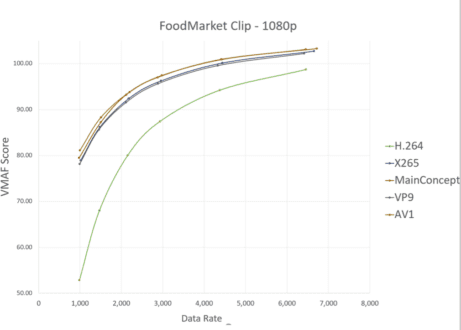I’ve been bullish on AV1 since the start, but I’m starting to think the codec is both farther away and less useful than I initially thought. Here’s what’s happening.
For Streaming Media East in June 2017, an AV1 member encoded four videos, totaling about 8.5 minutes, to five data rates each for 720p, 1080p, and 4K, and the output quality was noticeably superior to HEVC. Five months later, for Streaming Media West, I used seven very short clips totaling under one minute and the same vendor could only produce six versions each for 720p and 1080p, and none at 4K. That’s because encoding at 4K took too long, even in a virtually unlimited CPU cloud-based encoding farm.
Even worse, the visual quality of the AV1 clips had regressed to HEVC levels as measured by VMAF (see above; you can download the entire handout here). The company that encoded the video thought this might relate to a bug; another knowledgeable party ventured that it related to trade-offs in the code intended to accelerate encoding. Either way, the outlook, this close to a supposed code freeze at the end of the year, isn’t good.
I’m presenting at Streaming Tech Sweden in about two weeks. If any member of the Alliance for Open Media (or another vendor) wishes to encode my clips and allay these fears, get in touch at [email protected]. If you’re interested in hearing more about AV1, note that Google’s Jai Krishnan, product manager of AV1, will also be at the show detailing AV1’s status.
The choice between AV1 and HEVC is one of the more critical decision points facing streaming professionals in 2018 and beyond. These findings make me wonder when AV1 will be relevant, and to who. I hope an AOM member can help me update my AV1 findings, and look forward to hearing what Jai has to say at the show.
 Streaming Learning Center Where Streaming Professionals Learn to Excel
Streaming Learning Center Where Streaming Professionals Learn to Excel









